Abstract
Numerous studies have shown associations between the FOXO3A gene, encoding the forkhead box O3 transcription factor, and human or specifically male longevity. However, the associations of specific FOXO3A polymorphisms with longevity remain inconclusive. We performed a meta-analysis of existing studies to clarify these potential associations. A comprehensive search was conducted to identify studies of FOXO3A gene polymorphisms and longevity. Pooled odds ratios (ORs) and 95% confidence intervals (CIs) were calculated by comparing the minor and major alleles. A total of seven articles reporting associations of FOXO3A polymorphisms with longevity were identified and included in this meta-analysis. These comprised 11 independent studies with 5241 cases and 5724 controls from different ethnic groups. rs2802292, rs2764264, rs13217795, rs1935949 and rs2802288 polymorphisms were associated with human longevity (OR = 1.36, 95% CI = 1.10–1.69, P = 0.005; OR = 1.20, 95% CI = 1.04–1.37, P = 0.01; OR = 1.27, 95% CI = 1.10–1.46, P = 0.001; OR = 1.14, 95% CI = 1.01–1.27 and OR = 1.24, 95% CI = 1.07–1.43, P = 0.003, respectively). Analysis stratified by gender indicated significant associations between rs2802292, rs2764264 and rs13217795 and male longevity (OR = 1.54, 95% CI = 1.33–1.79, P < 0.001; OR = 1.38, 95% CI = 1.15–1.66, P = 0.001; and OR = 1.39, 95% CI = 1.15–1.67, P = 0.001), but rs2802292, rs2764264 and rs1935949 were not linked to female longevity. Moreover, our study showed no association between rs2153960, rs7762395 or rs13220810 polymorphisms and longevity. In conclusion, this meta-analysis indicates a significant association of five FOXO3A gene polymorphisms with longevity, with the effects of rs2802292 and rs2764264 being male-specific. Further investigations are required to confirm these findings.
Keywords: FOXO3A, longevity, meta-analysis, polymorphism
INTRODUCTION
Human life expectancy is a complex phenotype affected by various environmental and genetic factors. Genetic factors contribute to human aging and longevity through the modulation of biologic pathways,1 and genetic variation in the insulin/"insulin-like" growth factor-1 signaling pathway has been shown to affect human longevity.2,3 Recent studies found associations between variants of the FOXO3A gene (also known as FKHR-L1), which forms part of the insulin/insulin-like growth factor-1 signaling pathway, and human longevity.4,5,6,7
The human FOXO3A gene (6q21, MIM 602681) encodes the multifunctional forkhead box O3 transcription factor, which belongs to the FOXO (Forkhead box, class O) subfamily of transcription factors characterized by an evolutionarily conserved DNA-binding domain. In mammals, the FOXO subfamily consists of four genes, FOXO1, FOXO3, FOXO4 and FOXO6. A previous study suggested that FOXO1, FOXO4 and FOXO6 were not associated with human longevity.8 FOXO proteins are involved in diverse cellular and physiological processes, including cell proliferation, apoptosis, reactive oxygen species response, longevity, cancer and regulation of the cell cycle and metabolism.9
In 2008, Willcox et al.4 first reported a strong association between the FOXO3A gene and longevity in long-lived American men of Japanese ancestry. Anselmi et al.5 subsequently validated this association in men from a southern Italian centenarian study. These findings suggest that FOXO3A may play a role in determining longevity, especially in males. Several case-control studies have investigated the associations of FOXO3A polymorphisms with longevity, and FOXO3A has been linked to human longevity in Japanese,4 Italian,5 German6 and Chinese7 populations. However, these studies reported conflicting results regarding the roles of some specific polymorphisms in determining longevity.
No comprehensive meta-analysis has yet been conducted to evaluate the associations between specific FOXO3A polymorphisms and longevity. We therefore performed a meta-analysis of 11 case-control studies to explore the associations of eight FOXO3A polymorphisms (rs2802292, rs2764264, rs13217795, rs1935949, rs2802288, rs2153960, rs7762395 and rs13220810) with longevity, and to clarify any gender-specific effects of these polymorphisms. The results of this study will provide the most comprehensive evidence for the roles of specific FOXO3A gene polymorphisms in determining human longevity.
MATERIALS AND METHODS
Study selection
We performed a systematic search of literature published prior to July 2013 in PubMed, EMBASE, the Cochrane Library, ScienceDirect, Springerlink, Scirus, Chinese Biomedical (CBM, Chinese) and Chinese National Knowledge Infrastructure (CNKI, Chinese) databases using the keywords ‘FOXO3A’, ‘FKHR-L1’, ‘FOXO3’, ‘longevity’, ‘long life’, ‘long lifespan’ and combined phrases. Additional literature was collected by cross-referencing original and review articles. No language restrictions were applied. A flow diagram of the search strategy is shown in Figure 1. Studies were required to meet the following inclusion criteria: (i) published before July 2013; (ii) case-control or cohort studies; (iii) case subjects were long-lived, control subjects had average lifespans or were younger people; results from different ethnicities or different genders within a study were treated as separate studies and (iv) enough information to calculate odds ratios (ORs) with 95% confidence intervals (CIs). Exclusion criteria were: (i) not case-control or cohort studies evaluating the association of the FOXO3A polymorphisms with longevity; (ii) case reports, letters, reviews, editorials or correspondence articles; (iii) studies based on incomplete raw data and (iv) studies that contained duplicate data.
Figure 1.
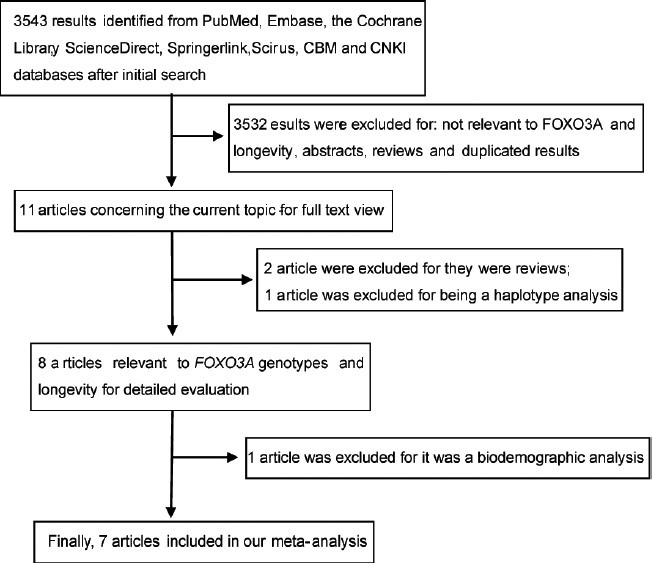
Flow diagram of the study selection process. CBM: Chinese Biomedical; CNKI: Chinese National Knowledge Infrastructure.
Data extraction
All data were extracted independently by two investigators (JB and XS) according to prespecified selection criteria. Discrepancies were resolved by a third investigator (YH). The following data were extracted from the included studies: name of the first author, publication year, ethnicity of the population, available genotype, numbers of cases and controls, ages of the cases and controls and results of studies.
Statistical analysis
Meta-analyses were performed for polymorphisms investigated in at least two studies. The strength of the associations between FOXO3A gene polymorphisms and longevity were estimated by ORs and 95% CIs. ORs and respective 95% CIs were calculated by comparing the minor and major alleles.
Heterogeneity among studies in terms of degree of association was assessed using χ2 tests. The I2 statistic was used to estimate the percentage of variation between the results that was caused by heterogeneity, rather than sampling error (I2 < 50% was treated as no significant heterogeneity). When heterogeneity was detected, the OR was pooled according to a random-effect model using the DerSimonian and Laird method; otherwise, a fixed-effect model using the Mantel–Haenszel method was selected.10 The significance of the pooled OR was determined by the Z-test.
Sensitivity analyses were carried out to evaluate the stability of the results of the meta-analysis. The influence of individual studies was evaluated by estimating the pooled ORs in the absence of each study.11
Potential publication bias was assessed by Begg's adjusted correlation test12 and visual inspection of Begg's funnel plots. For all analyses, a P value < 0.05 was considered to represent statistical significance for all comparisons. All statistical analyses were performed using Stata statistical software, version 12.0 (Stata Corp., College Station, TX, USA).
RESULTS
Study selection and characteristics
We initially identified 3543 results relevant to the search terms in the selected databases (Figure 1). After reading the titles and abstracts, 11 articles2,4,5,6,7,13,14,15,16,17,18 were included for full-text review. Of these, two articles2,16 were excluded because they were reviews and one article17 was removed because it was a haplotype analysis. After further screening, one further article18 was excluded because it was a biodemographic analysis. A total of seven articles4,5,6,7,13,14,15 including 11 independent case-control studies that examined the associations of FOXO3A gene polymorphisms with longevity were finally selected for meta-analysis. Six of the articles were written in English and one article15 was in Chinese. Of the 11 studies, seven focused on both genders, two on males and two on females. The characteristics of the studies are presented in Table 1.
Table 1.
Characteristics of studies investigating associations of FOXO3A polymorphisms with longevity
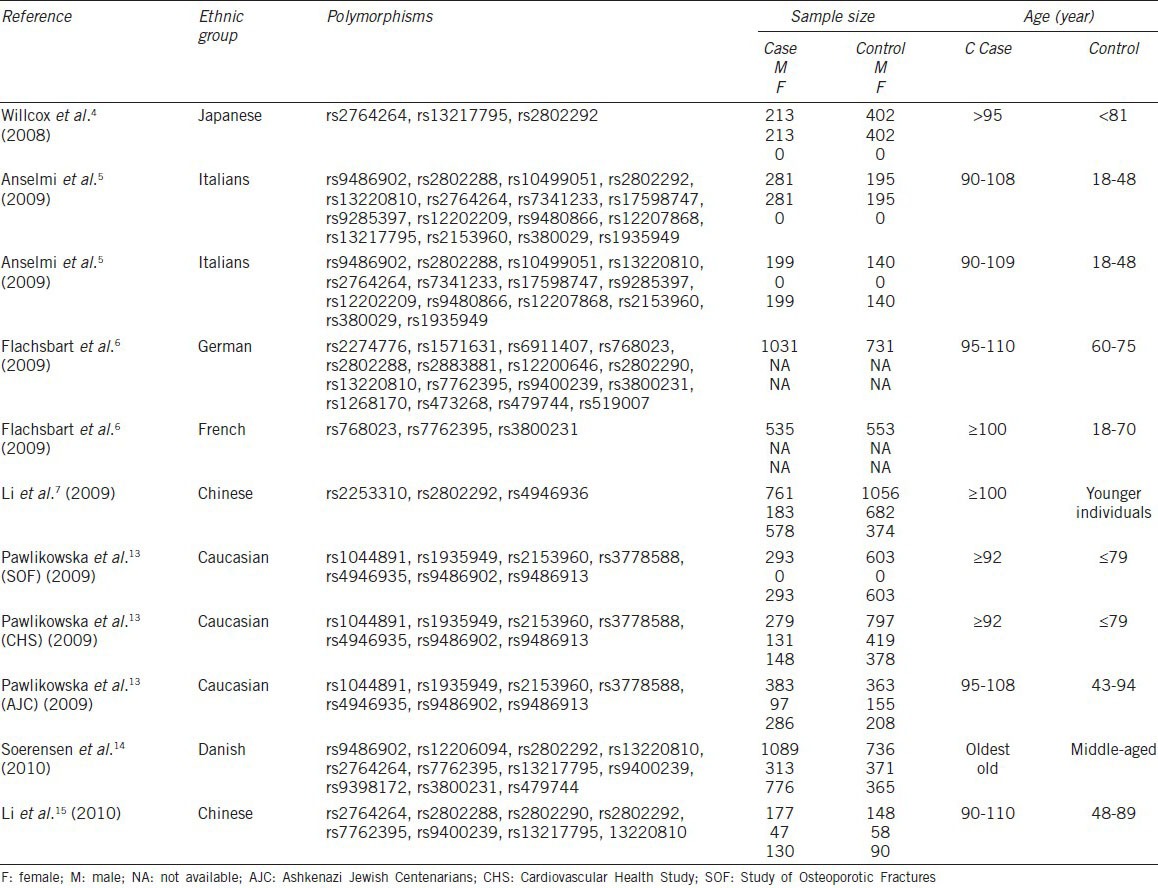
rs2802292 polymorphism
Analysis in overall population
The association of the FOXO3A rs2802292 polymorphism with longevity was investigated in five independent studies including a total of 2521 cases and 2537 controls. The distributions of genotype and allele frequencies in each case-control study are shown in Table 2. The genotype distributions in the control groups were consistent with the Hardy–Weinberg equilibrium. The Q-test of heterogeneity was significant and the analysis was therefore conducted using a random-effect model. There was a significant association between rs2802292 polymorphism and prolonged life span in the overall population, when comparing the G and T alleles (Forest plot shown in Figure 2), TG + TT vs GG, TG + GG vs TT, GG vs TT and TG vs TT genotypes (OR = 1.36, 95% CI = 1.10–1.69, P = 0.005; OR = 0.612, 95% CI = 0.395–0.949, P = 0.028; OR = 1.507, 95% CI = 1.025–2.216, P = 0.037; OR = 1.97, 95% CI = 1.11–3.51, P = 0.021 and OR = 1.38, 95% CI = 0.98–1.96, P = 0.066, respectively). Furthermore, we included three studies4,5,7 in which the controls were highly consistent with the Hardy–Weinberg equilibrium to validate the association and the results again showed a strong association of the rs2802292 polymorphism with longevity (OR = 1.47, 95% CI = 1.31–1.65, P < 0.001).
Table 2.
rs2802292 genotype distributions and allele frequencies in cases and controls
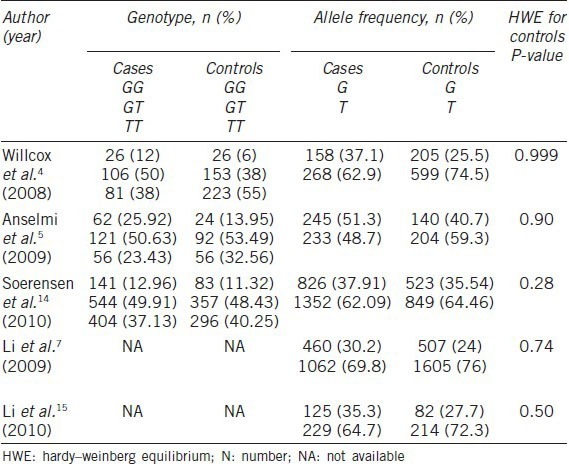
Figure 2.
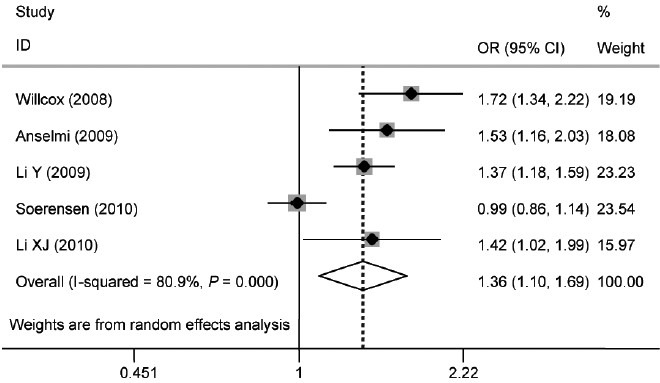
Meta-analysis of the association between rs2802292 and longevity (G vs T). CI: confidence interval; OR: odds ratio.
Analysis in males
Two independent studies4,5 reported a strong association between FOXO3A genotype and extreme male longevity. We therefore conducted a sub-analysis of four studies (990 cases and 1650 controls) using a random-effect model to investigate the role of the rs2802292 polymorphism, specifically in male longevity. The rs2802292 polymorphism showed a strong association with longevity in males (OR = 1.54, 95% CI = 1.33–1.79, P < 0.001).
Analysis in females
Stratified analysis of the rs2802292 polymorphism in females included two studies (1354 cases and 739 controls) and was conducted using a random-effect model. There was no significant association of the rs2802292 polymorphism with female longevity (OR = 1.16, 95% CI = 0.86–1.57, P = 0.34). The Forest plot is shown in Figure 3.
Figure 3.
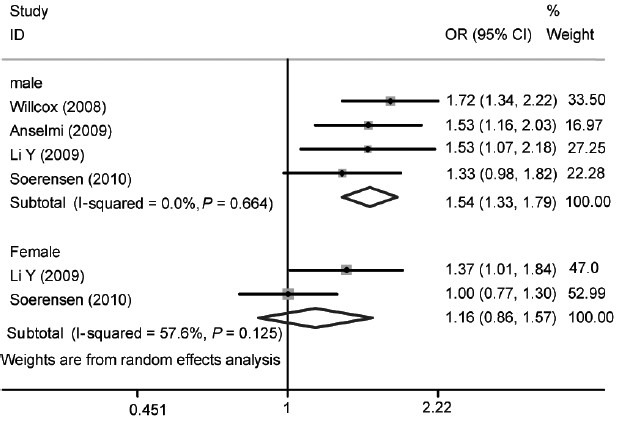
Meta-analysis of the association between rs2802292 and longevity (G vs T): subgroup analysis by gender. CI: confidence interval; OR: odds ratio.
rs2764264 polymorphism
Analysis in overall population
The association between the FOXO3A rs2764264 polymorphism and longevity was investigated in five independent studies including a total of 1959 cases and 1621 controls. There was no significant between-study heterogeneity by Q-test and the analysis was therefore conducted using a fixed-effect model. We detected a significant association of rs2764264 with longevity in terms of the C vs the T allele (OR = 1.20, 95% CI = 1.04–1.37, P = 0.01).
Analysis in males
Two studies including 807 cases and 968 controls were included in a subgroup analysis of rs2764264 in males. The Q-test of heterogeneity was not significant and the analysis was conducted using a fixed-effect model. A significant association between rs2764264 and male longevity was observed (OR = 1.38, 95% CI = 1.15–1.66, P = 0.001).
Analysis in females
Two studies (975 cases and 505 controls) were included in a stratified analysis to explore the relationship between rs2764264 and female-specific longevity. The result showed absence of association of the rs2764264 polymorphism with female longevity (OR = 0.93, 95% CI = 0.76–1.14, P = 0.508).
rs13217795 polymorphism
Analysis in overall population
Four independent studies with a total of 1706 cases and 1481 controls were included in the meta-analysis of rs13217795. The Q-test of heterogeneity was not significant and the analysis was conducted using a fixed-effect model. There was a significant association between the FOXO3A rs13217795 polymorphism and longevity in terms of the C vs the T allele (OR = 1.27, 95% CI = 1.10–1.46, P = 0.001).
Analysis in males
We only conducted a male-specific meta-analysis in three studies, because of insufficient data. The Q-test of heterogeneity was not significant and the data were analyzed using a fixed-effect model. The rs13217795 polymorphism showed a significant association with male longevity (OR = 1.39, 95% CI = 1.15–1.67, P = 0.001).
rs1935949 polymorphism
Analysis in overall population
A meta-analysis of the association of the FOXO3A rs1935949 polymorphism with longevity was conducted in five independent studies, including 1435 cases and 2098 controls. The Q-test of heterogeneity was not significant and a fixed-effect model was therefore used to conduct the analysis. We found a significant association between the rs1935949 polymorphism and longevity in terms of the C allele vs the T allele (OR = 1.14, 95% CI = 1.01–1.27).
Analysis in females
Two studies (492 cases and 743 controls) were included in the subgroup analysis to investigate any female-specific effect of the rs1935949 polymorphism on longevity. There was significant between-study heterogeneity by Q-test and the analysis was therefore conducted using a random-effect model. No significant association between this polymorphism and female longevity was found (OR = 1.03, 95% CI = 0.83–1.23).
rs2802288 polymorphism
Four independent studies comprising 1688 cases and 1214 controls were included in the meta-analysis of the FOXO3A rs2802288 polymorphism. There was no significant between-study heterogeneity by Q-test and the analysis was conducted using a fixed-effect model. A significant association of the rs2802288 polymorphism with prolonged life span was detected in terms of the A allele versus the G allele (OR = 1.24, 95% CI = 1.07–1.43, P = 0.003).
rs2153960 polymorphism
Analysis in overall population
A meta-analysis of the FOXO3A rs2153960 polymorphism was performed based on five independent studies (1435 cases and 2098 controls). The Q-test of heterogeneity was not significant and the analysis was conducted using a fixed-effect model. The result showed no significant association between this polymorphism and longevity in terms of the C allele versus the T allele (OR = 1.11, 95% CI = 0.98–1.23).
Analysis in females
Although rs2153960 was not associated with longevity in the overall population, we investigated its effect in females by analysis of data from two suitable studies. There was no association of rs2153960 with female longevity (OR = 1.07, 95% CI = 0.87–1.28).
rs7762395 polymorphism
The association of the FOXO3A rs7762395 polymorphism with longevity was investigated in four independent studies including 2832 cases and 2168 controls. The Q-test of heterogeneity was not significant and the analysis was conducted using a fixed-effect model. The result showed absence of association between the rs7762395 polymorphism and prolonged life span in terms of the A allele versus the G allele (OR = 1.11, 95% CI = 0.95–1.30, P = 0.173).
rs13220810 polymorphism
Analysis in overall population
A meta-analysis of the association between the FOXO3A rs13220810 polymorphism and longevity included four independent studies with a total of 1746 cases and 1219 controls. The Q-test of heterogeneity was not significant and a fixed-effect model was used. There was no significant association of the rs13220810 polymorphism with longevity when comparing the C allele versus the T allele (OR = 0.90, 95% CI = 0.76–1.06, P = 0.217).
Analysis in males
Two studies (594 cases and 566 controls) were subjected to subgroup analysis for male-specific effects. There was no significant between-study heterogeneity by Q-test and a fixed-effect model was therefore used. No significant association between rs13220810 and male longevity was observed (OR = 0.77, 95% CI = 0.61–1.01, P = 0.33).
Analysis in females
We conducted a stratified analysis in females including two available studies (975 cases and 505 controls) and using a fixed-effect model, but no significant association of the rs13220810 polymorphism with female longevity was detected (OR = 0.97, 95% CI = 0.76–1.25, P = 0.838). Summary of the results of this meta-analysis is listed in Table 3.
Table 3.
Meta-analysis of associations between FOXO3A gene polymorphisms and longevity
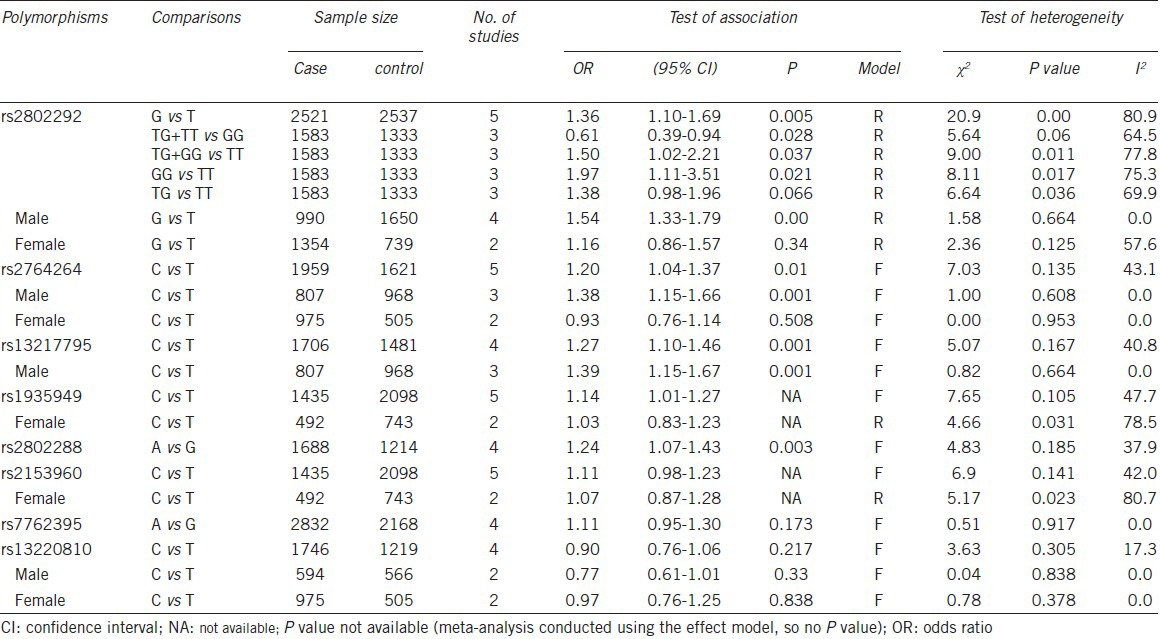
Sensitivity analysis
Sensitivity analyses were performed after the sequential removal of each eligible study to assess the influence of each individual study on the pooled OR. Sensitivity analyses revealed that one independent study by Soerensen et al.14 was the main source of heterogeneity in the analysis of the rs2802292 polymorphism; the heterogeneity was effectively reduced when this study was excluded (G vs T: OR = 1.46, 95% CI = 1.31–1.63, I2 = 0, Pheterogeneity= 0.481). In addition, no single study changed the pooled ORs qualitatively, suggesting that the results were relatively stable.
Publication bias
We conducted Begg's test to evaluate potential publication bias. There was no statistical evidence of publication bias regarding analysis of the rs2802292 polymorphism (G vs T: P =0.806) and funnel plots suggested no substantial asymmetry (Figure 4). There was no publication bias for other results.
Figure 4.
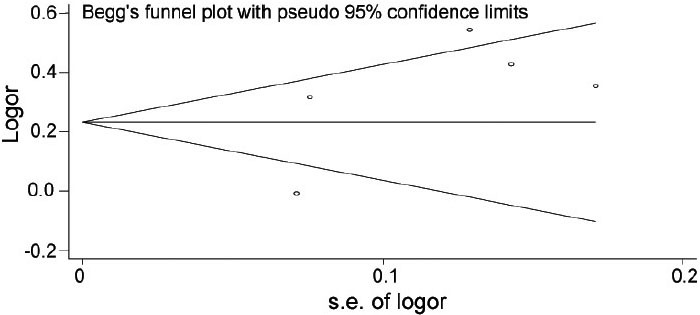
Begg's funnel plot for publication bias in selection of studies regarding the rs2802292 polymorphism (G vs T). s.e.: standard error.
DISCUSSION
Aging is the result of complex interactions among genetic, epigenetic and environmental factors, but genetic components appear to have a strong impact on survival to extreme age.19 Human longevity is considered to be a multifactorial phenotype with a genetic contribution of 20%–30%.20,21 Genome-wide association studies using single nucleotide polymorphism (SNP) analysis have successfully identified loci for various quantitative traits.22 Since APOE was confirmed as the first longevity gene,23 several genes have been considered as candidate longevity genes. Increasing numbers of studies have revealed associations between polymorphic variants of the FOXO3A gene and longevity.16,17 FOXO3A polymorphisms have repeatedly been identified in numerous populations with the ability to survive into old age, but the findings remain inconsistent, indicating the need to investigate these polymorphisms at a meta-analytical level.
The current study, to the best of our knowledge, represents the first meta-analysis of the associations between the rs2802292, rs2764264, rs13217795, rs2802288, rs7762395 and rs13220810 polymorphisms and human longevity and the most comprehensive meta-analysis to evaluate the association of FOXO3A polymorphisms with longevity. The pooled ORs indicated that rs2802292, rs2764264, rs13217795, rs1935949 and rs2802288 were linked to longevity, while subgroup analyses validated significant associations of rs2802292 and rs2764264 polymorphisms with longevity in males, but not females.
Although the FOXO3A gene has been considered as a convincing longevity gene and some SNPs in FOXO3A have been associated with human longevity, the mechanisms responsible for this effect remain unclear. Common polymorphisms with a modest effect on lifespan have been identified in the APOE gene.24 Interestingly, although the FOXO3A rs2802292, rs2764264, rs13217795, rs1935949 and rs2802288 polymorphisms were associated with human longevity, the rs2153960, rs7762395 and rs13220810 polymorphisms showed no such association, indicating that different FOXO3A polymorphisms could have potentially large effects on aging phenotypes and longevity. Small differences in FOXO3A could theoretically modify several downstream genes related to DNA binding, protein-protein interactions, cell cycle progression, apoptosis and metabolism.4
Our study suggests that the rs2802292 polymorphism is strongly associated with human longevity. The most familiar FOXO3A intronic SNP rs2802292 is characterized by a G to T transversion. A twin cohort study suggested that carriers of the minor G allele of rs2802292 showed reduced fasting plasma insulin and lower incremental area under the curve 0–120 min for insulin following oral glucose loading compared with non-carriers, indicating that the minor G allele was associated with enhanced peripheral and hepatic insulin sensitivity, possibly mediated through increased FOXO3A mRNA expression.25 Improved insulin sensitivity has been considered as a feature of long-lived individuals. However, a previous study found no associations between FOXO3A SNPs (rs2802288, rs1935949, rs9372190, rs2883881, rs2764264, rs13217795, rs9480867 and rs3800227) and type 2 diabetes and related parameters, suggesting that these SNPs influence longevity via an entirely different mechanism.26 These findings indicate that different FOXO3A polymorphisms may affect human longevity through different mechanisms.
The rs2764264, rs13217795, rs1935949 and rs2802288 polymorphisms are all intronic SNPs and are thought to be associated with human longevity. However, these polymorphisms have largely been explored in case-control studies and other investigations to uncover their functions and mechanisms are rare. A previous study suggested that coding variants of the FOXO3A gene may not be key players in human aging.27 Coding genes account for less than one-third of the evolutionarily conserved genome.28 It is possible that variations do not need to affect coding genes and intronic SNPs of the FOXO3A gene may play important roles in longevity.
A novel finding of the present study was the significant association between rs2802292 and rs2764264 polymorphisms and male longevity (OR = 1.54, 95% CI = 1.33–1.79, P < 0.001 and OR = 1.38, 95% CI = 1.15–1.66, P = 0.001, respectively). Neither of these polymorphisms showed any association with female longevity, suggesting that rs2802292 and rs2764264 manifest male-specific influences on longevity. rs13217795 was also associated with male longevity, while rs1935949 was not linked to female longevity; however, we were unable to conduct stratified analyses of these two polymorphisms in both genders because of insufficient data, and the existence of gender-specific influences on longevity thus remains unclear. The genetic contribution to longevity may be affected by gender; gender is a major variable in the genetics of longevity, and men and women follow different strategies to reach longevity.29 Several genes involved in determining life span have been found to have different influences on the probability of achieving longevity in men and women,30 and some investigations have already reported a gender gap in the impact of genetic factors on longevity.30,31,32,33,34,35,36,37 Specifically, three previous studies observed similar male-specific differences between young people and centenarians.31,32,33 The profound effect of the insulin/insulin-like growth factor-1 signaling pathway on the reproductive/hormonal system, which differs between males and females, suggests that variants that affect genes in this pathway become gender-specific enriched/depleted as the populations age.5 Our study suggests that men carrying the minor G allele of the rs2802292 polymorphism or the minor C allele of the rs2764264 polymorphism live longer than non-carriers. These male-specific longevity polymorphisms may serve as markers to help identify potentially long-lived men.
Heterogeneity is an important issue in meta-analysis. We detected significant between-study heterogeneity in the analysis of the rs2802292 polymorphism. However, sensitivity analyses identified one independent study14 as the main source of the heterogeneity, which was effectively decreased when this study was excluded. This study14 was conducted in a Danish population, suggesting that certain effects of genetic variants may be ethnic-specific. In addition to ethnicity, environmental factors, such as socioeconomic factors, medical security and living environment, may influence the genetic associations and thus contribute to heterogeneity in these studies. No single study exhibited excessive influence, suggesting that the results of this meta-analysis were relatively stable. In addition, Begg's funnel plots and Begg's tests did not detect any publication bias, indicating that the results were unbiased.
This study had several limitations that should be taken into account when considering its contributions. First, all the case-control studies included in our meta-analysis were observational studies. Second, heterogeneity among studies existed in some comparisons of polymorphisms. Third, the language selection bias should be considered. Our analysis was based on English and Chinese electronic databases, even though there was no language restriction in the initial search strategy. Fourth, the limited sample size and insufficient data meant that stratified analysis by gender could only be performed for some polymorphisms and subgroup analysis by ethnicity or age group was also restricted. Finally, because genotypes and allele frequency distributions were unavailable for some studies, we only evaluated allelic associations for most of the polymorphisms, and analyses of other comparative genetic models were restricted in some polymorphisms, except for rs2802292. These factors should be taken into consideration when interpreting the results of this meta-analysis.
In summary, this meta-analysis based on 5241 cases indicated that five FOXO3A gene polymorphisms are associated with longevity. rs2802292 and rs2764264 are male-specific longevity polymorphisms that could act as markers to identify potentially long-lived men. Larger, well-designed studies, as well as Genome-wide association studies, are needed to confirm these findings. Moreover, future studies should evaluate gene-gene and gene-environment interactions to clarify the role of the FOXO3A gene in longevity.
AUTHOR CONTRIBUTIONS
SCZ and QC conceived and designed the study. JMB and XLS performed the literature searches and extracted the data. JMB, XLS and SCZ performed the statistical analysis and wrote the manuscript. YQH, HLZ, CL, TZ and WC were involved in the interpretation of the results. All authors read and approved the final manuscript.
COMPETING INTERESTS
The authors declare no competing interests.
ACKNOWLEDGMENTS
This study was supported by two grants from the National Natural Science Foundation of China (No. 81072092, No. 81328017) and a grant from Guangdong Provincial Science and Technology Projects of China (2012B031800302).
REFERENCES
- 1.Lunetta KL, Murabito JM. Genetics of human longevity and healthy aging. In: Newman AB, Cauley JA, editors. The Epidemiology of Aging. New York: Springer; 2012. pp. 215–35. [Google Scholar]
- 2.Ziv E, Hu D. Genetic variation in insulin/IGF-1 signaling pathways and longevity. Ageing Res Rev. 2011;10:201–4. doi: 10.1016/j.arr.2010.09.002. [DOI] [PubMed] [Google Scholar]
- 3.Bonafè M, Olivieri F. Genetic polymorphism in long-lived people: cues for the presence of an insulin/IGF-pathway-dependent network affecting human longevity. Mol Cell Endocrinol. 2009;299:118–23. doi: 10.1016/j.mce.2008.10.038. [DOI] [PubMed] [Google Scholar]
- 4.Willcox BJ, Donlon TA, He Q, Chen R, Grove JS, et al. FOXO3A genotype is strongly associated with human longevity. Proc Natl Acad Sci U S A. 2008;105:13987–92. doi: 10.1073/pnas.0801030105. [DOI] [PMC free article] [PubMed] [Google Scholar]
- 5.Anselmi CV, Malovini A, Roncarati R, Novelli V, Villa F, et al. Association of the FOXO3A locus with extreme longevity in a southern Italian centenarian study. Rejuvenation Res. 2009;12:95–104. doi: 10.1089/rej.2008.0827. [DOI] [PubMed] [Google Scholar]
- 6.Flachsbart F, Caliebe A, Kleindorp R, Blanché H, von Eller-Eberstein H, et al. Association of FOXO3A variation with human longevity confirmed in German centenarians. Proc Natl Acad Sci U S A. 2009;106:2700–5. doi: 10.1073/pnas.0809594106. [DOI] [PMC free article] [PubMed] [Google Scholar]
- 7.Li Y, Wang WJ, Cao H, Lu J, Wu C, et al. Genetic association of FOXO1A and FOXO3A with longevity trait in Han Chinese populations. Hum Mol Genet. 2009;18:4897–904. doi: 10.1093/hmg/ddp459. [DOI] [PMC free article] [PubMed] [Google Scholar]
- 8.Kleindorp R, Flachsbart F, Puca AA, Malovini A, Schreiber S, et al. Candidate gene study of FOXO1, FOXO4, and FOXO6 reveals no association with human longevity in Germans. Aging Cell. 2011;10:622–8. doi: 10.1111/j.1474-9726.2011.00698.x. [DOI] [PubMed] [Google Scholar]
- 9.Tzivion G, Dobson M, Ramakrishnan G. FoxO transcription factors; Regulation by AKT and 14-3-3 proteins. Biochim Biophys Acta. 2011;1813:1938–45. doi: 10.1016/j.bbamcr.2011.06.002. [DOI] [PubMed] [Google Scholar]
- 10.DerSimonian R, Laird N. Meta-analysis in clinical trials. Control Clin Trials. 1986;7:177–88. doi: 10.1016/0197-2456(86)90046-2. [DOI] [PubMed] [Google Scholar]
- 11.Tobias A. Assessing the influence of a single study in the meta-analysis estimate. Stata Tech Bull. 1999;8:15–7. [Google Scholar]
- 12.Begg CB, Mazumdar M. Operating characteristics of a rank correlation test for publication bias. Biometrics. 1994;50:1088–101. [PubMed] [Google Scholar]
- 13.Pawlikowska L, Hu D, Huntsman S, Sung A, Chu C, et al. Study of Osteoporotic Fractures. Association of common genetic variation in the insulin/IGF1 signaling pathway with human longevity. Aging Cell. 2009;8:460–72. doi: 10.1111/j.1474-9726.2009.00493.x. [DOI] [PMC free article] [PubMed] [Google Scholar]
- 14.Soerensen M, Dato S, Christensen K, McGue M, Stevnsner T, et al. Replication of an association of variation in the FOXO3A gene with human longevity using both case-control and longitudinal data. Aging Cell. 2010;9:1010–7. doi: 10.1111/j.1474-9726.2010.00627.x. [DOI] [PMC free article] [PubMed] [Google Scholar]
- 15.Li XJ, Zhang ZY, Qin J, Zhang N, Rong MH, et al. Correlation between FOXO3A gene polymorphisms and human longevity in Bama County, Guangxi Province. J Environ Health. 2010;1:54–6. [Google Scholar]
- 16.Chung WH, Dao RL, Chen LK, Hung SI. The role of genetic variants in human longevity. Ageing Res Rev. 2010;9:S67–78. doi: 10.1016/j.arr.2010.08.001. [DOI] [PMC free article] [PubMed] [Google Scholar]
- 17.Kuningas M, Mägi R, Westendorp RG, Slagboom PE, Remm M, et al. Haplotypes in the human Foxo1a and Foxo3a genes; impact on disease and mortality at old age. Eur J Hum Genet. 2007;15:294–301. doi: 10.1038/sj.ejhg.5201766. [DOI] [PubMed] [Google Scholar]
- 18.Zeng Y, Cheng L, Chen H, Cao H, Hauser ER, et al. Effects of FOXO genotypes on longevity: a biodemographic analysis. J Gerontol A Biol Sci Med Sci. 2010;65:1285–99. doi: 10.1093/gerona/glq156. [DOI] [PMC free article] [PubMed] [Google Scholar]
- 19.Capri M, Salvioli S, Sevini F, Valensin S, Celani L, et al. The genetics of human longevity. Ann N Y Acad Sci. 2006;1067:252–63. doi: 10.1196/annals.1354.033. [DOI] [PubMed] [Google Scholar]
- 20.Herskind AM, McGue M, Holm NV, Sørensen TI, Harvald B, et al. The heritability of human longevity: a population-based study of 2872 Danish twin pairs born 1870-1900. Hum Genet. 1996;97:319–23. doi: 10.1007/BF02185763. [DOI] [PubMed] [Google Scholar]
- 21.Skytthe A, Pedersen NL, Kaprio J, Stazi MA, Hjelmborg JV, et al. Longevity studies in Genom EU twin. Twin Res. 2003;6:448–54. doi: 10.1375/136905203770326457. [DOI] [PubMed] [Google Scholar]
- 22.Manolio TA, Brooks LD, Collins FS. A HapMap harvest of insights into the genetics of common disease. J Clin Invest. 2008;118:1590–605. doi: 10.1172/JCI34772. [DOI] [PMC free article] [PubMed] [Google Scholar]
- 23.Nebel A, Kleindorp R, Caliebe A, Nothnagel M, Blanché H, et al. A genome-wide association study confirms APOE as the major gene influencing survival in long-lived individuals. Mech Ageing Dev. 2011;132:324–30. doi: 10.1016/j.mad.2011.06.008. [DOI] [PubMed] [Google Scholar]
- 24.Christensen K, Johnson TE, Vaupel JW. The quest for genetic determinants of human longevity: challenges and insights. Nat Rev Genet. 2006;7:436–48. doi: 10.1038/nrg1871. [DOI] [PMC free article] [PubMed] [Google Scholar]
- 25.Banasik K, Ribel-Madsen R, Gjesing AP, Wegner L, Andersson A, et al. The FOXO3A rs2802292 G-allele associates with improved peripheral and hepatic insulin sensitivity and increased skeletal muscle-FOXO3A mRNA expression in twins. J Clin Endocrinol Metab. 2011;96:E119–24. doi: 10.1210/jc.2010-0881. [DOI] [PubMed] [Google Scholar]
- 26.Nair AK, Sugunan D, Kumar H, Anilkumar G. Association analysis of common variants in FOXO3 with type 2 diabetes in a South Indian Dravidian population. Gene. 2012;491:182–6. doi: 10.1016/j.gene.2011.09.032. [DOI] [PubMed] [Google Scholar]
- 27.Donlon TA, Curb JD, He Q, Grove JS, Masaki KH, et al. FOXO3 gene variants and human aging: coding variants may not be key players. J Gerontol A Biol Sci Med Sci. 2012;67:1132–9. doi: 10.1093/gerona/gls067. [DOI] [PMC free article] [PubMed] [Google Scholar]
- 28.Altshuler D, Daly MJ, Lander ES. Genetic mapping in human disease. Science. 2008;322:881–8. doi: 10.1126/science.1156409. [DOI] [PMC free article] [PubMed] [Google Scholar]
- 29.Franceschi C, Motta L, Valensin S, Rapisarda R, Franzone A, et al. Do men and women follow different trajectories to reach extreme longevity? Italian Multicenter Study on Centenarians. Aging (Milan) 2000;12:77–84. doi: 10.1007/BF03339894. [DOI] [PubMed] [Google Scholar]
- 30.Corbo RM, Pinto A, Scacchi R. Gender-specific association between FSHR and PPARG common variants and human longevity. Rejuvenation Res. 2013;16:21–7. doi: 10.1089/rej.2012.1365. [DOI] [PubMed] [Google Scholar]
- 31.De Benedictis G, Rose G, Carrieri G, De Luca M, Falcone E, et al. Mitochondrial DNA inherited variants are associated with successful aging and longevity in humans. FASEB J. 1999;13:1532–6. doi: 10.1096/fasebj.13.12.1532. [DOI] [PubMed] [Google Scholar]
- 32.De Benedictis G, Carotenuto L, Carrieri G, De Luca M, Falcone E, et al. Gene/longevity association studies at four autosomal loci (REN, THO, PARP, SOD2) Eur J Hum Genet. 1998;6:534–41. doi: 10.1038/sj.ejhg.5200222. [DOI] [PubMed] [Google Scholar]
- 33.Barbieri M, Bonafè M, Rizzo MR, Ragno E, Olivieri F, et al. Gender specific association of genetic variation in peroxisome proliferator-activated receptor (PPAR) gamma-2 with longevity. Exp Gerontol. 2004;39:1095–100. doi: 10.1016/j.exger.2004.03.034. [DOI] [PubMed] [Google Scholar]
- 34.Bonafè M, Olivieri F, Cavallone L, Giovagnetti S, Mayegiani F, et al. A gender-dependent genetic predisposition to produce high levels of IL-6 is detrimental for longevity. Eur J Immunol. 2001;31:2357–61. doi: 10.1002/1521-4141(200108)31:8<2357::aid-immu2357>3.0.co;2-x. [DOI] [PubMed] [Google Scholar]
- 35.Lio D, Scola L, Crivello A, Colonna-Romano G, Candore G, et al. Gender-specific association between -1082 IL-10 promoter polymorphism and longevity. Genes Immun. 2002;3:30–3. doi: 10.1038/sj.gene.6363827. [DOI] [PubMed] [Google Scholar]
- 36.Tan Q, Yashin AI, Bladbjerg EM, de Maat MP, Andersen-Ranberg K, et al. Variations of cardiovascular disease associated genes exhibit sex-dependent influence on human longevity. Exp Gerontol. 2001;36:1303–15. doi: 10.1016/s0531-5565(01)00102-4. [DOI] [PubMed] [Google Scholar]
- 37.Napolioni V, Lucarini N. Gender-specific association of ADA genetic polymorphism with human longevity. Biogerontology. 2010;11:457–62. doi: 10.1007/s10522-010-9266-7. [DOI] [PubMed] [Google Scholar]


